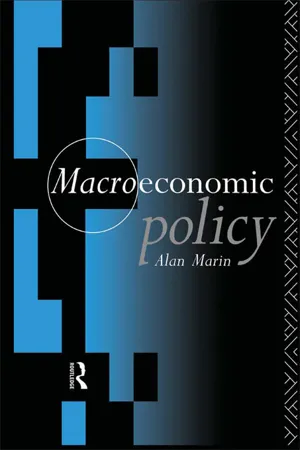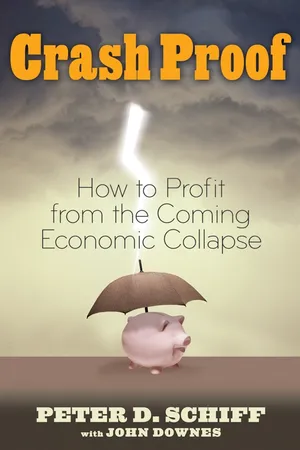Economics
Demand Pull Inflation
Demand-pull inflation occurs when the demand for goods and services exceeds their supply, leading to an increase in prices. This type of inflation is often associated with strong economic growth and can be caused by factors such as increased consumer spending, government stimulus, or investment. As demand outstrips supply, businesses may raise prices to balance the market.
Written by Perlego with AI-assistance
Related key terms
4 Key excerpts on "Demand Pull Inflation"
- eBook - ePub
- Alan Marin(Author)
- 2005(Publication Date)
- Routledge(Publisher)
Another definitional point might be raised here. One far too often comes across the statement, purporting to be a definition, that ‘inflation is a process of too much money chasing too few goods’. This purported definition is, in fact, an implicit explanation of inflation, not a definition, and it will be discussed under the causes of inflation and not as part of the definition.Figure 4.1 Change in equilibrium price level following shift in demand or supplyDemand-pull and cost-push
Much of the early attempts to explain inflation often divided the theories into two groups: first demand-pull, second cost-push. There are various meanings given to this distinction and these meanings have changed over time to an extent that the terms are often unclear and therefore we shall try to restrict our use to those cases where there should be no confusion. At one time the distinction was between those who believed that inflation was caused by shifts in aggregate demand as compared to those who thought that inflation was caused by shifts in aggregate supply. This distinction relates to the simplest of price theory models. If in Fig. 4.1 we consider a single market initially in equilibriumat a price P 0 then the price can rise to P1 for one of two reasons: either because the demand curve shifted from d 0 d 0 to d'd' while the supply curve remains at s 0s 0 or because the supply curve shifted from s 0 s 0 to s's' while the demand curve remains unchanged. Either of these would lead to a rise in price in the case of a single product and the demand-pull/cost-push distinction was simply applying this model to the economy as a whole.Our impression is that distinguishing demand-pull from cost-push on this basis is now much less popular. The reason is that the distinction just described will only be useful in the case of a once-and-for-all price rise rather than in the case of a continuing process of inflation. It perhaps made sense 30–40 years ago, when the rule was assumed to be stable prices and the question asked was what started off a particular episode of inflation. Once inflation has been going on for decades, the question of what originally started it so many years ago is not a very relevant one, as compared to discussing the conditions that allow inflation to continue. The demand-pull/cost-push distinction of demand curve shift versus supply curve shift is less useful for this. Once inflation has got under way, a shif t in the demand curve may itself lead to a rise in the supply curve as workers want higher wages and feel that firms can afford to pay them. Similarly, an increase in the supply curve could lead to a rise in the demand curve for products because workers have more money income. - eBook - ePub
- Krish Bhaskar, David F. Murray(Authors)
- 2015(Publication Date)
- Routledge(Publisher)
There are two further problems which we must mention here. Inflation is generally considered to be undesirable yet an annual increase in the general level of prices of, say, 1.5 per cent may be argued by some economists to be beneficial in stimulating economic growth whereas they would join the consensus of opinion against a 25 per cent per annum rise. The problem of deciding when the rate of increase in prices becomes unacceptable therefore remains. Secondly, a distinction is often made between price inflation which refers to the rate of increase of prices and wage inflation which refers to the rate of increase of money wages. Inflation is normally measured by the rate of increase of prices, although clearly wages and prices are closely related.Demand pull and cost push inflation
The models considered earlier in the book have generally assumed a downward sloping aggregate demand curve and an upward sloping aggregate supply curve which provides a convenient framework within which to consider the two main ways in which price inflation may occur.The first is generally known as Demand Pull Inflation and reflects a rightward shift in the aggregate demand curve as shown in Figure 15.1 . It is often loosely described as a situation where ‘too much money is chasing too few goods’ and is simply a situation where the demand for goods and services at the existing price level outweighs the supply, leading to an increase in the price level.Figure 15.1 The effect on the price level of an increase in aggregate demandIt is often argued that at less than full employment the aggregate supply curve is similar to that shown in Figure 15.1 but that as full employment is reached output cannot easily be increased, in the short run at least, and the aggregate supply curve becomes steeper as shown3 by the dotted line in Figure 15.1 . The effect of this is to generate a greater increase in the price level for a given movement in the aggregate demand curve.One source of theories of inflation is therefore concerned with the factors affecting the aggregate demand curve since this in turn affects the price level. These are the so-called demand pull theories. The second main approach to the theory of inflation is generally known as cost push inflation and considers the factors which might produce a leftward shift in the aggregate supply curve as shown in Figure 15.2 - eBook - ePub
Crash Proof
How to Profit From the Coming Economic Collapse
- Peter D. Schiff, John Downes(Authors)
- 2010(Publication Date)
- Wiley(Publisher)
Consumer price index, year-over-year change, 1997-2006. Even the government’s own highly flawed and greatly manipulated index revealed inflation was accelerating even as the government and Wall Street claimed that it was well contained. By the time the problem was partially acknowledged, the government’s response was too little and too late.Source: Reprinted by permission from David L. Tice and Associates (www.prudentbear.com ).WHAT INFLATION IS AND ISN’T
Inflation means expansion, in the same sense that a balloon expands when you blow air into it. In economics, inflation refers to expansion of the amount of dollars in circulation, called the money supply. When new money or credit is added to an economy, thus diluting the existing supply, the general level of prices (aggregate prices) will rise, assuming the amount of goods and services within the system stays the same. But understand the distinction: The money supply expands and contracts. Prices go up and down. Inflation and price increases are not the same thing. One is cause. The other is effect.The reason that expansion of the money supply causes aggregate prices to rise is simple. As the supply of dollars grows relative to the supply of goods, more dollars are needed to buy a given quantity of goods. In other words, the dollar’s value is diminished relative to the goods available for sale. It’s basic supply, represented by sellers, and demand, represented by buyers. Any kid who collects baseball cards understands it. The more a particular card is in circulation, the less it is worth. The value of a card is a function of its scarcity. The more abundant the supply, the less something is worth. The same holds true for money.HOW INFLATION CREATES ARTIFICIAL DEMAND
So inflation is monetary expansion or, in other words, more money chasing a constant or diminishing supply of goods and services. It doesn’t have to be physical dollars added to the supply of money. It can just as well be expanded credit. Anything that artificially increases aggregate demand for goods and services is inflation. Printing money - Marc R. Tool(Author)
- 2019(Publication Date)
- Routledge(Publisher)
The problem is to discover both reasons and remedies for this, a central objective of this article. Conservative economic opinion, particularly as reflected in the latest Economic Report, sees institutional characteristics of the labor market such as the minimum wage and unemployment compensation as the prime factors keeping unemployment high in the face of rising demand. 12 In contrast, and as will be argued subsequently in detail, we have to look in a more fundamental way into the institutions that determine economic power and govern the distribution of money income before we can find an answer to the dilemma of simultaneous and excess inflation and unemployment. Our final observation at this point is related directly to the foregoing, taking us to the heart of the problem. By the end of the 1960s the character of the inflation underwent a basic change, from a “demand-pull” inflation to one of the “cost-push” variety. The evidence? Simply put, an inflation that persists and even accelerates at times in the face of continued (and even growing) slack in the economic system can only be accounted for in “cost-push” terms. For evidence on the slack state of the economy during the 1970s, we need only to point to the fact that capacity utilization was below the average of the prior two decades, unemployment was on the average significantly higher than in either the 1950s or 1960s, and the “gap” between potential and actual output was greater on the average than it was in the 1950s. 13 The crucial question, the issue to which we now turn, is, How can we account for the persistence of inflation in the face of such tendencies toward chronic stagnation? The Roots of Inflation If we leave aside the clear case of an inflation caused by excess demand under full employment conditions (the situation from 1966 to 1969), we are left with two contending explanations
Learn about this page
Index pages curate the most relevant extracts from our library of academic textbooks. They’ve been created using an in-house natural language model (NLM), each adding context and meaning to key research topics.



